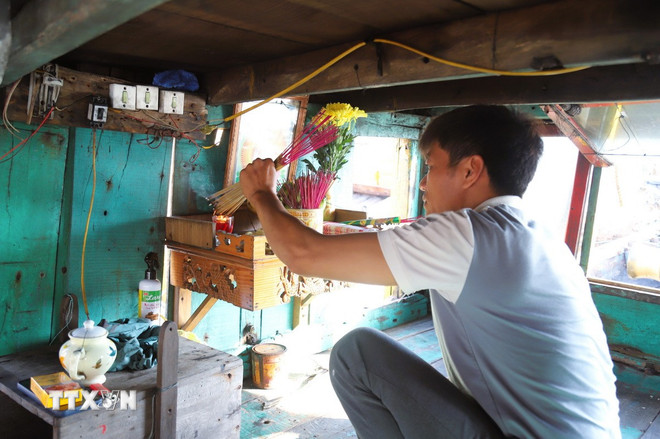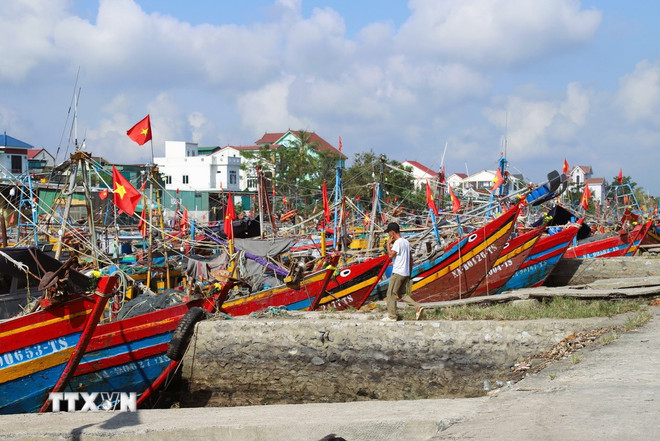For generations, in the minds of coastal people in the hamlets of Quyet Thang, Quyet Thanh, Hai Trung, Chien Thang, Hai Dong, Hai Bac... (Dien Chau commune, Nghe An province), the full moon of the seventh lunar month (July 15th of the lunar calendar) has had a very important spiritual meaning in the rituals of the life cycle.
On this day, families, relatives, and clans will hold full moon worship ceremonies to remember and show gratitude to ancestors and origins, show filial piety to parents with a sincere heart, and hope that their wishes in daily life will come true.
The traditional beauty of organizing full moon worship is not only found in the coastal hamlets of Dien Bich commune but also in the mountainous and semi-mountainous areas of Nghe An province.
However, with their origin as fishermen and their economy closely linked to the river and ocean environment, fishermen in the Dien Chau foothills have a unique and distinctive way of celebrating the full moon, which has been preserved and passed down for generations.
Sincerely offer boat together
Early in the morning of the 15th day of the 7th lunar month, when the night mist had not yet cleared and people's faces were not yet clear, fishermen who had slept overnight on their boats and ships anchored at the piers on the Dien Kim River (Dien Chau and Hai Chau communes) woke up to light incense sticks and place them on the bow of the boat and on the altar in the cockpit.
As the sun rose from the Lach Van estuary, groups of villagers, carrying baskets and trays containing offerings and sacrifices, followed each other to the wharf to worship the boat.
For coastal fishermen, boats are not only a valuable asset but also stay with them all year round. Therefore, the owners of the vessels always consider their boats as their second home. Worshiping the boat is a mandatory ritual for every fisherman, not only on full moon days but also when Tet and Spring come.
Mr. Le Van Phi, a fisherman in Quyet Thang hamlet, Dien Chau commune, Nghe An province, said that on the full moon day, fishermen often hold boat and ship worshiping ceremonies early to have time to worship their ancestors at home, at the ancestral temple, and to visit relatives and friends. Boat worshiping ceremonies do not necessarily have to be held on the morning of the full moon day but can be held the previous afternoon. The boat worshiping ceremony does not have to be "full of offerings" but depends on the conditions of each family that owns the boat or ship.

However, the ritual to display on the boat offering tray must have enough flowers (yellow chrysanthemums), some votive paper money, some betel leaves smeared with lime, a few fresh areca nuts, a boiled chicken, a plate of sea salt, white wine, a small metal knife (or can be made of wood or bamboo crafted in the shape of a knife)...
After arranging the offerings on the altar in the cockpit, the ship owner reports to the river god, sea god, and supernatural beings who watch over the river banks, waterways, and estuaries about the family's seafood exploitation activities during the past time.
At the same time, the boat owner prays for calm seas and no storms, lots of shrimp and fish; boats, machinery and fishing gear are not damaged; crew members on board ships, boats, and fishing teams are always united, healthy, close, and love each other like brothers in a family.
On the morning of the full moon day, on the Lach Van River, Bung River, Dien Thuy River, and Lach Van estuary (Dien Chau Commune), more than 500 fishing boats and ships of Dien Chau Commune fishermen specializing in offshore seafood exploitation have anchored in all the river sections. Boat worshiping activities take place at all the anchorages. The air is filled with the scent of agarwood, carried by the sea breeze into every alley of the fishing village.
Not only worshiping boats, fishermen also arrange time to go to whale shrines at river mouths and seaports to offer incense and flowers, praying for good luck in their seafood exploitation activities at sea.
Fishermen from Quyet Thang and Quyet Thanh villages go to Nghia Chung Temple; fishermen from Ngoc Minh, Yen Quang, Dong Loc villages... go to Thien Temple, Ngu Ong Temple and Ong Bung Temple. Fish graves located along the foot of the dike and the beach are also visited by many coastal people to display offerings, burn incense, and respectfully pray for good things.
Mr. Nguyen Huu Ha, Dong Loc hamlet, Dien Chau commune, Nghe An province said that fishing is a hard job and also has many risks because of storms and unusual whirlwinds that arise at sea. In the subconscious of fishermen, the whale is very sacred, a guardian angel in the vast ocean, protecting fishermen from natural disasters and storms, helping to calm the waves and sea. Therefore, the custom of worshiping the whale has existed for a long time in coastal areas. Fishermen are always grateful to the whale, so when their boats are not at sea, they often bring offerings to temples, shrines, and whale graves to express their gratitude and pray for good things in life and work at sea.
Unique customs of welcoming the full moon
With the concept of "the whole year has the full moon of July, all have the full moon of January", the coastal people of Dien Chau commune (Nghe An province) consider the full moon of July as a sacred holiday. On this occasion, every family prepares offerings, organizes filial piety activities at home, in the family, or organizes ancestral worship ceremonies, worship ceremonies at the church in a bustling, jubilant but warm atmosphere. People studying, working, working, living far away from home in all parts of the country all turn to their homeland and hometown on this occasion.
A few days before the full moon day, families and clans in the area mobilize their children and grandchildren to clean the sacrificial objects, decorate the family altars and the family temples; clean the mausoleums and graves, light incense sticks and pray respectfully, inviting the souls of ancestors and grandparents to come and eat the full moon with their children and grandchildren.

Early in the morning of the full moon day, the rural market quickly becomes crowded and bustling. Typical products for sale in the coastal market are seafood such as shrimp, crab, fish, squid, snails... and vegetables, tubers, and fruits. On the full moon day, vendors also sell a lot of beans, sticky rice, peanuts, sesame, fruits, and votive paper.
On the full moon day, descendants will hold a ceremony to pay respect to their ancestors at the family temple or ancestral hall to remember, show gratitude and report to their ancestors about the achievements that their descendants have achieved in the past. From early morning, families prepare offerings to bring to the temple or ancestral hall in time. The offerings include sticky rice with beans, sticky rice with peanuts or sticky rice with gac fruit, boiled chicken or boiled pig's head.
On every village road, people carry offerings to worship in large numbers. The people in charge of carrying offerings are women and mothers, all dressed neatly. The offering trays to the ancestors are covered with a basket and a thin cloth to prevent passersby from seeing the offerings inside. At the same time, a mulberry branch is placed on the offering tray to ward off evil spirits and protect the offering tray to always be pure.
The worshiping ceremony at the church and the family temple takes place in a solemn, sacred and respectful atmosphere. The rituals of offering incense, offering wine, reading the eulogy, and paying tribute to the ancestors are performed by the elders. Each ceremony has a master of ceremonies, chanting and performing the ceremony to the sound of gongs and drums; then the descendants burn incense and bow to their ancestors, praying for health, peace and luck.
After the ceremony, the clans held a ceremony to commend and give gifts to children with high academic achievements in the school year; propagated the clan's rules and regulations to their descendants before organizing the ceremony to receive blessings from their ancestors.
After finishing the worship at the church or family temple, families also display ancestral offerings at home to show their respect for their roots and filial piety towards their parents and grandparents./.
Source: https://www.vietnamplus.vn/nghe-an-doc-dao-phong-tuc-cung-ram-thang-bay-o-nhung-mien-chan-song-post1060271.vnp





![[Photo] Urgently help people soon have a place to live and stabilize their lives](/_next/image?url=https%3A%2F%2Fvphoto.vietnam.vn%2Fthumb%2F1200x675%2Fvietnam%2Fresource%2FIMAGE%2F2025%2F12%2F09%2F1765248230297_c-jpg.webp&w=3840&q=75)











































































![[Photo] General Secretary To Lam works with the Standing Committees of the 14th Party Congress Subcommittees](https://vphoto.vietnam.vn/thumb/402x226/vietnam/resource/IMAGE/2025/12/09/1765265023554_image.jpeg)


































Comment (0)